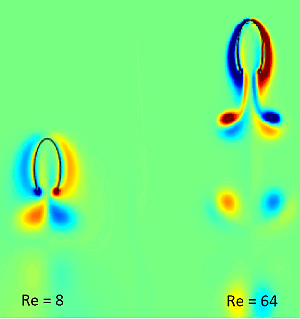SICB Annual Meeting 2012
January 3-7, 2012
Charleston, SC
Symposium: Combining experiments with modeling and computational methods to study animal locomotion
Recent advances in computational methods have made realistic large-scale simulations of animal locomotion possible. This has resulted in numerous mathematical and computational studies of locomotion with the purpose of improving the design of micro-air and underwater vehicles, motivating the development of improved numerical methods, and enhancing our understanding of stability and maneuverability. How such mathematical studies can improve our understanding of organisms in the context of their environment and physiology remains relatively unexplored. For example, nature has evolved a wide variety of fascinating mechanisms of locomotion that exploit the properties of complex materials and fluids. Only recently have researchers been able to use mathematical and computational tools to rigorously compare the relative advantages and disadvantages of these forms of locomotion in different environments. Similarly, advances in computational physiology now allow investigators to explore how changes at the molecular and cellular levels could lead to significant changes in performance at the level of the organism.

Vorticity plots showing simulation results of jellyfish jet propulsion at two Reynolds numbers. In: G. Herschlag and L. Miller. Reynolds number limits for jet propulsion: A numerical study of simplified jellyfish. Journal of Theoretical Biology, 285(1): 84-95 (2011).
Objectives: The goal of the symposium and associated workshop at the 2012 Meeting of the Society of Integrative and Comparative Biology is to encourage investigators in organismal biology to use recent computational advances in fluid-structure interaction problems, stochastic modeling, and complex fluids and materials to answer fundamental questions in ecomechanics, functional morphology, and comparative physiology. One emphasis of the symposium will be to illustrate the synergy between modeling, experiments, and simulation in studies of animal locomotion. Another emphasis of the symposium will be to highlight mathematical models that combine multiple levels of biological organization to understand how small changes in tissue physics can result in large changes in performance at the organismal level. The purpose of the workshop is to facilitate discussions about effective training of students and the professional development of junior faculty who are working in an explicitly interdisciplinary context of biology, mathematics, theory, and simulation.
Sponsors: Funding for this symposium is provided by the National Science Foundation and the SICB Divisions of Comparative Biomechanics, Ecology and Evolution, Invertebrate Zoology, Neurobiology, and Vertebrate Morphology.
Organizers
- Laura Miller, University of North Carolina
- Silas Alben, Georgia Institute of Technology
Associated Workshop on “Research and Training at the Interface of Theory and Experiment.”
We have funding for 8 junior participants to travel to the 2012 SICB Annual Meeting in Charleston, SC and participate in the workshop associated with the symposium. A group of 4 senior researchers at the interface of mathematical modeling and experiment will share their experiences in training students and carrying out multidisciplinary research. The workshop will then break up into subgroups to discuss each of the following topics:
1) Running an experimental lab in a math or theoretical department
2) Working as a theorist in a experimentally dominated department
3) Being a successful interdisciplinary researcher in terms of where to publish, seek grants, navigate evaluations for tenure and promotion
4) Training students and postdocs in interdisciplinary work
5) Helping interdisciplinary students and postdocs launch their careers
Funding preference will be given to junior researchers interested in mathematics and organismal biology who do not typically attend the SICB meetings. Please send your CV and a one page letter summarizing your experiences and interest in the workshop to by October 1, 2012: math.organisms@gmail.com

The vortex wakes past a rigid flapping ?ber for increasing values of the pitching amplitude, ϴ: (a) 0.5 (b) 1 (c) 2 (d) 4 (e) 8 (f) 10 (g) 15 (h) 21 degrees (Alben, 2009). In each plot, a second black line shows the fiber at maximum amplitude. In: S. Alben. Simulating the dynamics of flexible bodies and vortex sheets. Journal of Computational Physics, 228: 2587-2603 (2009).
Speakers
S7-1.1 Friday, Jan. 6, 08:00 LAUDER, G. V.*; FLAMMANG, B.; ALBEN, S.:
Robotic models of fish body and caudal fin propulsion
S7-1.2 Friday, Jan. 6, 08:30 ALBEN, S.*; WITT, C.; BAKER, T.V.; ANDERSON, E.; LAUDER, G.V.:
Resonances in fish fin models
S7-1.3 Friday, Jan. 6, 09:00 TYTELL, E.D.*; HSU, C.-Y.; COHEN, A.H.; WILLIAMS, T.L.; FAUCI, L.J.:
Neuromechanical phase lags in swimming lampreys
S7-1.4 Friday, Jan. 6, 09:30 YEN, J.*; WEBSTER, D.; MURPHY, D.; CATTON, K. ; MITTAL, R.; ZHENG, L.:
Wake signatures formed at intermediate Re regimes: signals of prey, predators, mates or schoolmates.
S7-1.5 Friday, Jan. 6, 10:30 MILLER, Laura A:
Uncovering the aerodynamics of the smallest insects using numerical and physical models
S7-1.6 Friday, Jan. 6, 11:00 DUDEK, Dan:
Simple models for terrestrial locomotion and the materials that power it
S7-1.7 Friday, Jan. 6, 11:30 MCHENRY, MJ:
On the speed of lever systems
S7-2.1 Friday, Jan. 6, 13:00 WANG, Jane:
Stability and Control of Flapping Flight
S7-2.2 Friday, Jan. 6, 13:30 HEDRICK, TL:
Separating behavioral and passive dynamics in the pitch maneuvers of hawkmoths
S7-2.3 Friday, Jan. 6, 14:00 DANIEL, TL*; WILLIAMS, CD:
Modeling many molecular motors mostly motivated by moth movement
S7-2.4 Friday, Jan. 6, 14:30 GOLDMAN, Daniel I.:

